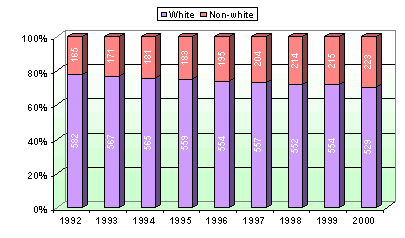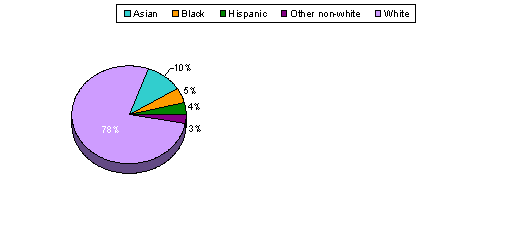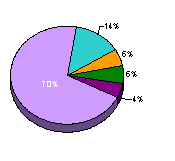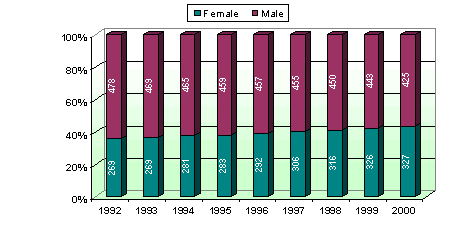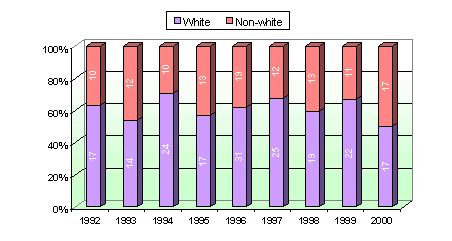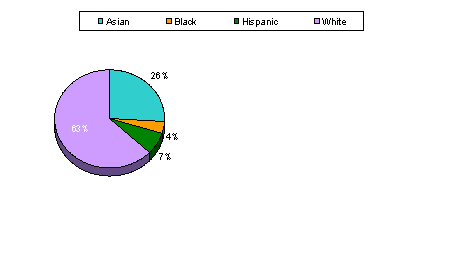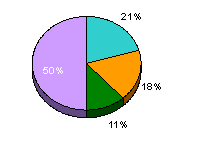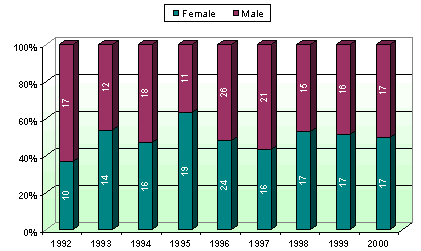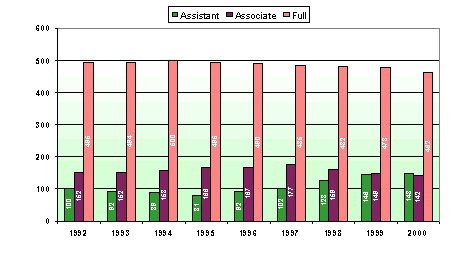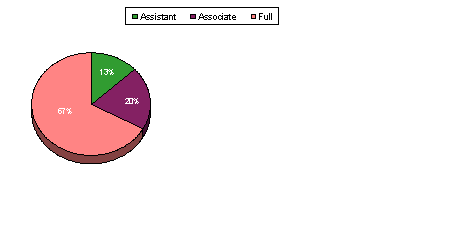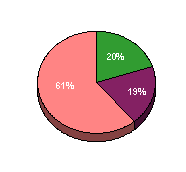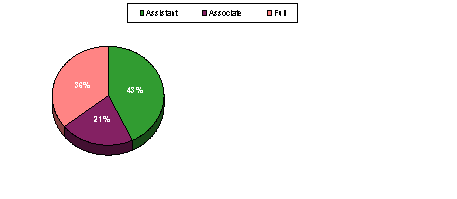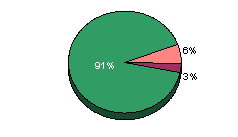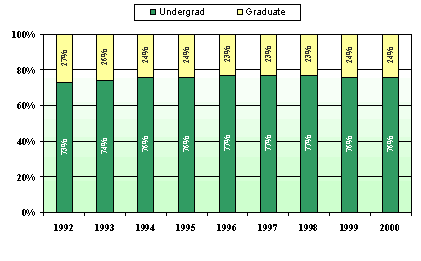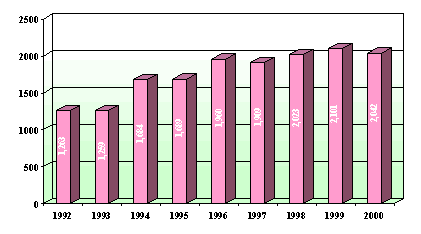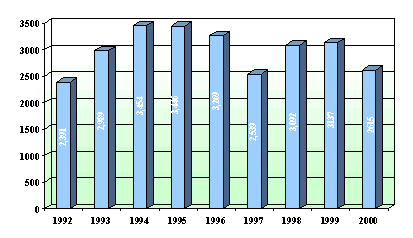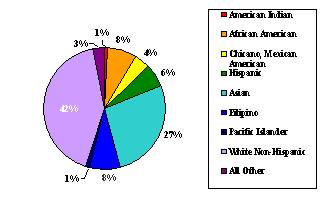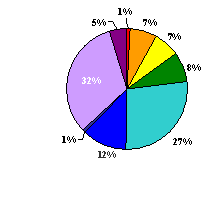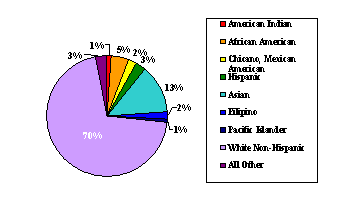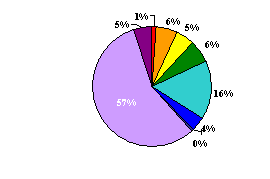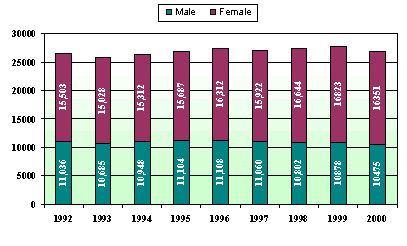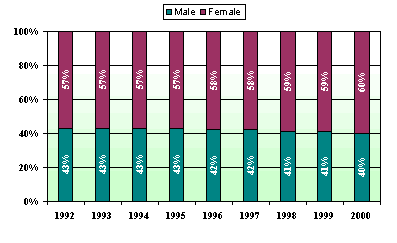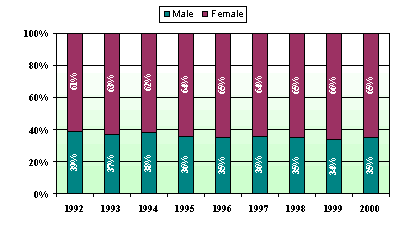|
In January of 1998, San Francisco State University secured approval from the Accrediting Commission for Senior Colleges and Universities of the Western Association of Schools and Colleges to engage in a special self-study for re-accreditation. The WASC approval letter of 12 January 1998 to President Corrigan noted that the university wished to "use the self study to describe, analyze, and assess the implementation of the strategic plan" and indicated that "(t)his is a project well suited to a reaffirmation self study. Your theme of academic excellence is consistent with our requirement that all special self study designs focus on student learning…."
|
|
x |
|
With that approval, the university was authorized to develop its self-study around the themes of its own
six-themed strategic plan. The strategic plan itself emerged from a broadly participatory, three-year process involving faculty, administrators, students, and staff. The university's self-study has focused primarily on its implementation and assessment endeavors between 1998 and 2000.
|
|
x |
|
The self-study that follows is structured around the six themes and is presented as a three-part document. The first part, entitled "Implementing the University Strategic Plan," begins with an overview of the university since the last WASC visit in the Spring of 1992, highlighting institutional characteristics and strategic planning endeavors between Fall 1992 and Spring 2000. The bulk of this part of the self-study depicts how the university has implemented and is continuing to implement the strategic plan approved by President Corrigan in August 1998 [Envisioning Our Second Century,
www.sfsu.edu/strategicplan/]. The major chapters of this part are thus structured around institutional attempts to promote and enhance performance in the plan's six identified thematic areas: academic excellence; teaching and learning success; diversity; user-friendliness; community responsibility; and internationalization of the campus.
|
|
x |
|
The second part, entitled "University Assessment Activities," gives a detailed view of both university-level and college-based assessment endeavors between 1992 and 2000, and especially between 1998 and 2000. It discusses university-wide approaches to reviewing academic programs, assessing General Education, and measuring institutional performance in enhancing student achievement and meeting student needs. An appendix to the self-study focuses on the assessment of student learning in the nine colleges of the university and in the student services area.
|
|
x |
|
The third part, entitled "Other Areas of University Planning and Implementation," places its attention on seven important areas of university activity not focused on in the strategic plan. These areas include the co-curricular learning experience; university development and advancement; financial planning and resource allocation; campus planning and development; research and sponsored programs; teacher preparation; and the university library.
|
|
x |
|
GUIDING THE PLANNING:
|
|
THE CHANGING ENVIRONMENT OF HIGHER EDUCATION
|
|
x |
|
The CSU is committed to developing educational programs which meet the needs of Californians facing the innovations and dislocations of an increasingly high-tech, international and integrated economy.… Every indication is that changes in technology, in the structure of markets, and in the social organization of work and communities will require working men and women to adapt quickly and adroitly. We must provide education which is relevant to those changes, affordable, and available.
|
|
—from Cornerstones: The CSU Planning Initiative
|
|
x |
|
At about the same time San Francisco State began its strategic planning process, the California State University
(CSU) was undertaking a similar effort. The starting point, Cornerstones: The CSU Planning Initiative, was presented by then-Chancellor Barry Munitz to the CSU Board of Trustees at its May 1996 meeting. Cornerstones called for a major endeavor to enable the CSU to become more responsive to the needs of the citizens of the State of California—an endeavor ultimately resulting in a CSU strategic plan entitled The Cornerstones Report: Choosing Our Future
[www.calstate.edu/cornerstones/]. Though developed independently, the SFSU and CSU plans reflect common values and concerns. Like the
CSU, San Francisco State University, as it enters its second century, is committed to identifying and responding to societal developments that are—and will be—affecting the university's community and the students coming to the university from that community. The university identified the following major trends and developments as significant for its planning. They informed the discussion throughout the strategic planning process.
|
|
x |
|
POPULATION INCREASE: A demographic bulge is moving along the educational pipeline in California. Projections indicate that California's school-age population will grow by 1.7 million—an increase of 25%—by the year 2005. Similar projections suggest that between 450,000 and 500,000 more Californians than were enrolled in 1995 will be seeking a college education in
2005 (1).
|
|
x |
|
The overall population of the Bay Area is projected to grow by 750,000, also by 2005. Roughly 80% of San Francisco State's enrolled students come from the Bay Area's nine counties. Ethnically, much of the growth locally, and especially the school-age growth, will come from the Latino and Asian American
portions of the population. Barring a major reversal in federal immigration policy, the Bay Area will also continue to be an important entry point for new
immigrants (2).
|
|
x |
|
(1) See the California Higher Education Center's
publication entitled Shared Responsibility: Strategies to Enhance Quality
and Opportunity in California Higher Education; San Jose, 1996.
(2) According to a front-page article in the New York
Times edition of July 4, 2000: "At some unknown moment in time
between now and July 1, 2001, if demographers are right, California will
become the first big state in the nation in which non-Hispanic whites are
officially no longer a majority". |
|
x |
|
Additionally, as a result of the aging of the baby boom generation, it is expected that the number of California baby boomers moving into the 45-64 age group will grow by almost three million by 2005. This projection, combined with accelerated changes in employment needs resulting in demands for re-education and training, suggests that more older persons will seek to re-enter degree and certificate programs.
|
|
x |
|
Issues that these demographics raise for SFSU include space and other resources to accommodate increased demand for the university’s programs; a need to increase the production of K-12 teachers to meet the state’s correspondingly greater need for them; and increased consideration of ways to provide students—particularly re-entry and working students—with education when and where they can take it in.
|
|
x |
|
ECONOMIC GROWTH: The economy of the Bay Area specifically and of California in general is poised to grow dramatically over the next decade. Most economists believe that the recession and slow growth of the early 90's was an anomaly and that the region and state will return to the pattern of outperforming the rest of the nation economically. There are significant aspects of this general growth that are important for the university. Growth by sector will be uneven; some traditional industries (aerospace, banking) are predicted to decline, while others (technology, telecommunications) will likely expand. In San Francisco and the Bay Area, particularly promising sectors are science and technology, international trade in manufactured products and services, arts and culture, and tourism and hospitality. Among impacts of the region’s economy on the university are the need to ensure that academic programs keep pace with changing knowledge and workplace demands and the need to engage with a housing environment (the Bay Area leads the nation in the price of housing) that greatly complicates faculty and administrative recruitment.
|
|
x |
|
EMPLOYMENT OPPORTUNITIES: Given this economic growth, there will be a sizable increase in demand for persons to fill professional and managerial jobs requiring a university degree. By one estimate, over 170,000 of these jobs will be created in the Bay Area by 2005. However, successfully competing for these jobs will require students to obtain particular sets of skills during their years at the university. Employers will be increasingly selective about the kinds of specific and general skills they seek in candidates. For instance, an employer may be interested not only in candidates with experience working on team projects (a general skill) but also in candidates with experience presenting project results using Microsoft Powerpoint (a specific skill). However, all employers will be looking for individuals with excellent communication, critical thinking, problem solving, and human relations skills.
|
|
x |
|
To turn out successful competitors in the job market of the next decade, the university must carefully tie the curricula of its educational programs to the workforce needs of potential employers in expanding sectors of the economy. Further, employees filling managerial and professional jobs will undergo a number of occupational and career changes through the course of their working lives. While they remain within an occupation, they will need to update their skills and abilities continually. When changing occupations, however, substantial new investments in education will be needed to navigate career changes successfully.
|
|
x |
|
FOCUS ON EDUCATIONAL DELIVERY AND OUTCOMES: We see an increasing focus nationally both on how education is delivered and on how learning is achieved and assessed. Much greater emphasis is also being placed on connecting what happens in school with what goes on at work. A number of aspects of these trends are important for the university. Greater emphasis will be placed on outcomes-based learning and on institutional accountability for the performance of graduates. Experiential learning and internships will become more highly valued. Employers will rely more heavily on certificate education and training programs. Increasingly, educational programs will be offered in a more student-centered and user-friendly fashion, with learning occurring at workplace and community sites in addition to college and university classrooms. Employees who are already college-educated will require post-graduate educational delivery systems tailored to their need to upgrade their skills and retrain for new occupations and careers.
|
|
x |
|
RESOURCES TIED TO ENROLLMENT: It is likely that the bulk of new budgeted CSU resources will be tied to enrollment growth for the foreseeable future. However, some new CSU resource growth may be tied to technology initiatives and enhancements; and some one-time funding may be available for new initiatives and specific projects (for example, experimentation with year-round operation and with new approaches to community service learning). Thus, to attract a greater budgetary allocation within the
CSU, the university will need to develop a vital and innovative program mix that reflects institutional self-identity while focusing on the needs of the university's community. Additional sources of funding from outside the CSU will likely depend upon the university's ability to buttress and to market its applied research capabilities.
|
|
x |
|
WHERE PLANNING HAS LED:
|
|
FROM WHO WE ARE TO WHAT WE WILL BECOME
|
|
x |
|
Starting in Fall 1995, San Francisco State University engaged in what was perhaps the most extensive and broadly participatory self-examination it had undertaken in its first century of existence. Conditions were right for a campus-wide effort to examine the university and to envision its future and the steps to that future. Fiscal recovery from California's recession of the early '90s, strong enrollment, projections for even higher student demand, a fast-changing State, new public attention to and demands on higher education, and an upcoming centennial combined to impel the university to develop a new strategic plan for a new stage in its institutional life.
|
|
x |
|
Accordingly, early in 1995, President Corrigan, in close consultation with the Academic Senate, created the Commission on University Strategic Planning (CUSP). The 24-person body, with both elected and appointed members, including faculty, staff, students, and administrators, developed a structure, process, and timetable for the strategic plan. CUSP, as the result of a highly deliberative process, established six planning groups to take up aspects of university life. Their reports, shared widely on campus and submitted to the commission at the end of the Spring 1996 semester, were the foundation for an integrated draft strategic plan, debated and ultimately approved by CUSP and presented to the campus community in Fall 1997. Then, during the 1997-98 academic year, CUSP reviewed the plan, in the light of comments received and of suggested implementation scenarios, before completing its work and submitting its report and recommendations to the president at the end of Spring 1998. President Corrigan approved the plan in August 1998 and the university then began the process of implementation, which is described later in this chapter.
|
|
x |
|
The university undertook its strategic planning process grounded in a clear sense of its mission. The mission statement
[www.sfsu.edu/~senate/S92-176.htm], adopted by the Academic Senate and approved by President Corrigan in 1992, identifies the need to:
|
|
x |
|
• Create and maintain an environment for learning that promotes respect for and appreciation of scholarship, freedom, human diversity, and the cultural mosaic of the City of San Francisco and the Bay Area;
|
|
x |
|
• Promote excellence in instruction and intellectual accomplishment; and
|
|
x |
|
• Provide broadly accessible higher education for residents of the region and state, as well as the nation and world.
|
|
x |
|
These commitments reappear in every segment of the strategic plan. Even the structure of the strategic planning process itself reflected these values, as the six planning groups took up the themes of:
|
|
x |
|
• Achieving academic excellence
|
|
x |
|
• Generating teaching and learning success
|
|
x |
|
• Combating discrimination
|
|
x |
|
• Creating a user-friendly campus
|
|
x |
|
• Fostering community responsibility
|
|
x |
|
• Internationalizing the university
|
|
x |
|
These themes were not meant to cover all aspects of university life but rather to focus on selected core areas of institutional concern. Other areas (e.g., technology, library, development) were not selected; in part, because they were already receiving appropriate university attention.
|
|
x |
|
Shaping and emerging from these planning committees was a shared understanding of the kind of community of individuals, groups, and constituencies making up the university, and of the tangible and intangible qualities that, by circumstance and by choice, have come to characterize San Francisco State. What made the planning process work so well was a coming together of individuals across organizational lines—individuals who shared varied expertise and perspectives toward a common purpose. What emerged in the strategic plan was a guideline to what the university wanted and needed to become in order to serve its community as well in the future as it had in the past.
|
|
x |
|
WHO WE ARE: A UNIVERSITY REVITALIZING THE
URBAN TRADITION
|
|
x |
|
Though the term "non-traditional" has often been applied to SFSU and other institutions that, like it, serve a largely urban population, that term is one both San Francisco State and its community have outgrown. The university sees itself as heir to a decades-old tradition: that of a comprehensive, responsive, and accessible institution reflecting the demographics and needs of a community of learners who are likely to be—like the cities from whence they come—diverse in race, age, country of origin, pathway to higher education, life experience, and goals. SFSU sees as a key part of this "urban tradition" an engagement with its community so fundamental that it is intertwined with the entire teaching and learning enterprise. The university thus sees its approach as "affirmative" education—teaching, learning, adding to knowledge, and serving in ways that effectively assert the right, the capability, and the opportunity of all members of its diverse learning community to develop knowledge and skills that will enrich their lives and better their shared society.
|
|
x |
|
This aim is finding fresh expression in the university’s strong commitment to service learning and service learning’s next generation—civic engagement. This civic mission—to provide students with the values and the skills that will lead them to participate actively and effectively in community life—has strong roots in the curriculum. However, it also requires the university itself to model this engagement and to become a civic leader, embracing a mission of community partnership as expressed in courses, university/community projects, research activities, and publications. In an urban setting, the opportunities to live out this civic mission are rich and varied.
|
|
x |
|
This revitalized urban tradition fosters a university that is necessarily dynamic and affected by community conditions. What does this mean for San Francisco State University? A snapshot of its teaching mission, faculty, students, staff, administration and governance, and academic programs provides an answer.
|
|
x |
|
TEACHING MISSION: Given the wide range of basic skills, experiential learning, cultural backgrounds, and aspirations of SFSU students—a range that is characteristic for public, urban universities—the teaching mission of the university is necessarily multifaceted. Like campuses across the nation, SFSU grapples with the needs of significant numbers of regularly admissible students who arrive without the level of basic skills they will need to succeed. At the same time, students may offer exceptional strengths and knowledge bred of life experience. These, too, are valuable college skills; and the faculty seek to recognize them and help students draw on them for academic ends.
|
|
x |
|
While seeing preparation for the workplace as one appropriate aim for instruction, the university also recognizes an obligation to help all students develop the qualities of mind and character that will enable them to be lifelong learners. This balancing of career-focused and "liberal" education is fundamental to the SFSU teaching mission. Technology can enrich and assist teaching and learning. The university has made a substantial commitment to technology access for faculty and students, providing the foundation for increased application of technology in the academic program. Many faculty have already developed creative new materials and approaches integrating technology. Continued expansion of these approaches will characterize the university in the years ahead. At the same time, faculty appreciate, and will preserve, the contact and personal exchange with students that is a university's particular value.
|
|
x |
|
FACULTY: SFSU faculty would certainly include themselves as a significant part of the institution's diverse community of learners. Deliberate efforts to bring more women and individuals of color onto the faculty have been strikingly successful. Between Fall 1992 and Fall 2000, the percentage of tenured/tenure-track female faculty has increased from 36% to 43%. During the same 1992-2000 period, the percentage of African American tenured/tenure-track faculty has increased from 5% to 6%; Hispanic faculty from 4% to 6%; and Asian faculty from 10% to 14%. By Fall 2000, 30% of the full-time tenured and tenure-track faculty were individuals of color, compared with 22% in Fall 1992. It should also be noted that 52% of 1999 tenure-track hires and 50% of 2000 hires were women; and 33% of hires in 1999 and 50% of hires in 2000 were individuals of color. Charts at the end of the chapter provide additional information regarding ethnicity, gender, and rank for tenured/tenure-track faculty and new faculty hires.
|
|
x |
|
Transcending all statistics is a set of shared faculty values which makes SFSU's affirmative education a reality. Faculty can recognize and respond to a wide range of backgrounds and life experiences, for they reflect a similar diversity themselves. They can understand the heavy demands made on students who often must juggle work, family responsibilities, and academic life, for a comprehensive university also makes comprehensive demands on its faculty to teach well, to engage in scholarly and professional work, and to serve on, and often off, the campus.
|
|
x |
|
The scholarly achievements of SFSU faculty demonstrate their determination and ability to meet the highest academic standards. Faculty grants and contracts have risen markedly in the last ten years, from $12 million to a high of $35 million. World-class work is done at the university, from discovery of planets, to musical composition, to new approaches to wheelchair construction for the Third World, to breakthroughs in our understanding of rain forest regeneration.
|
|
x |
|
Community engagement is not an obligation but a passion with many SFSU faculty, attested to by the range and vitality of programs linking classroom and community. Many faculty are deeply engaged with the community as part of their scholarship and/or as part of their citizenship—an approach to life the university would like its students to model. Faculty continue to create or to bring the university into partnership with exciting community programs. Even more comprehensively, university leadership is seizing opportunities to foster campus-business-community collaborations that address such current issues as the digital divide. Students gain greatly and so does the institution as a whole. SFSU is increasingly seen by the City's leaders as a valuable resource in building a better community.
|
|
x |
|
STUDENTS: The demographics of SFSU students, reflecting a panoply of backgrounds and paths to the university, have already been noted. A few facts and figures (for Fall 2000 unless otherwise noted) bring the 26,826 students of the "urban tradition" to life.
|
|
x |
|
A substantial proportion (38.4%) of the undergraduate student body is 21 or younger, the so-called "traditional" student age. However, the mean undergraduate student age is 24.1. The graduate population (approximately 24% of total student enrollment) is considerably older, with the mean age being 32.6. Racial and ethnic diversity is strong, with 68% of undergraduates and 43% of graduate students being individuals of color. (These percentages are up from 58% and 30%, respectively, in Fall 1992.) Of all of the university's students, 61% are women. In a representative student sample from the Spring 1999 SNAPS survey, one-fifth of students had lived in the United States for fewer than ten years, and over half spoke a language other than English at home when they were growing up. Charts at the end of the chapter provide additional information regarding student enrollment, age, ethnicity, and gender.
|
|
x |
|
Fifty-six percent of our undergraduate students come as transfers, many from community colleges. Many undergraduate students come from families of modest means. Of the new freshmen and transfer students for Fall 2000 who are financially dependent, 20% have a family income of less than $24,000; and an additional 23%, less than $48,000. In the 1999 SNAPS survey, half of the respondents’ fathers and 40% of their mothers had earned a baccalaureate or higher degree. The same survey showed 66% of students working, over 15% of them 40 hours a week or more. Half of all students receive some form of financial aid.
|
|
x |
|
Behind the figures lie the experiences. Central to the urban university tradition is the opportunity it offers students to remake their lives. New starts, second chances, and fulfillment of long-deferred dreams fill campus classrooms. However, so do as-yet undirected minds—students who are looking to the university to help them find a direction. One classroom can—and in a basic, required course very likely will—contain part- and full-time students; some straight from high school and some who left high school a decade ago; students supporting themselves; students supporting an entire family; students supported by their parents; visa students, immigrants, and the native born; students who have known war, or the struggle and tensions of the inner city, or the safety of a comfortable suburb. Many students in that classroom will be fluent in two or more languages; a number will have English as a second language; others will be native English speakers who need to strengthen their basic skills. They enter that classroom seeking different things. What they can all gain, in addition to subject knowledge, is exposure to more perspectives in one room than they are likely to encounter in so concentrated a form anywhere else in their lives. Clearly, this urban student population can itself be an educational resource; but clearly, too, the great range of readiness for college-level work is both a concern and a challenge for faculty and for students themselves.
|
|
x |
|
STAFF: The appeal of a university environment, a commitment to the nature and goals of this particular university, and the strong attraction of the Bay Area combine to give SFSU a staff that must be considered one of the institution's hidden values. Staff members with advanced degrees, strong professional
involvements, creative activities that they pursue outside their work day, and deep ties to a wide range of the communities that make up the Bay Area, comprise a rich collective resource. While workload is a serious issue, many staff members express a desire to put their knowledge and skills to broader use, both for the good of students and for their personal development. Thus, they too are an integral part of the community of learners.
|
|
x |
|
ADMINISTRATION AND GOVERNANCE: The changing administrative structure of the university has met the challenges of the 90s, as it has focused the institution more clearly on responding to emerging needs and trends. Foremost among these changes has been the president’s decision to place senior administrative responsibility in the hands of a team of vice presidents overseeing the areas of academic affairs, student affairs, business and finance (including facilities and service enterprises), and university advancement (including capital planning, design, and construction). During this period, the president also hired a highly experienced new provost/vice president for academic affairs and established a new, executive-level university deanship for human relations. The university emerged from this period with an effectively-focused and mutually-supportive top leadership team. (University organization charts for 2000 will be found at the end of this chapter.)
|
|
x |
|
During this same period, administrative interactions and relationships with the faculty and the institutional governance process have become more shared and distributed. There is now a close working relationship between the president and senior administrators, on the one hand, and the Executive Committee of the Academic Senate, on the other, stemming in large part from a building up of trust between the two groups during the mid and latter part of the 90s. According to one senate leader, there is now a "unique spirit of cooperation" between administration and faculty leadership. A good example of this positive working relationship is found in the process by which the institution's strategic planning endeavor was initiated, conducted, and concluded, and implementation and assessment activities put into place. The process by which the university's faculty and administrative leadership formulated a series of collectively agreed-upon responses to the CSU system's Cornerstones strategic planning initiative represents another significant example.
|
|
x |
|
ACADEMIC PROGRAMS: SFSU's academic programs are, like the university itself, comprehensive. They include the full range of arts and sciences, with strength both in the liberal arts and in a range of pre-professional and professional programs. In total, the university offers more than 200 undergraduate and graduate degree programs, a number of them characterized by a focus on interdisciplinary learning and by their responsiveness to community needs and issues.
|
|
x |
|
Since the 1991-92 academic year, new baccalaureate degree programs have been established in Asian American studies; child and adolescent development; criminal justice; environmental studies; and
kinesiology. At the graduate level, new degrees include an M.A. in Asian American Studies; an M.S. in Applied
Geosciences; an M.F.A. in Cinema; and a Master of Public Health. New minors include California studies; education; gay, lesbian, and bisexual studies; Jewish studies; and world development studies. Additionally, numerous new certificate programs have been established, primarily in the areas of health, special education, and human services. (All of the major curricular changes occurring at the university since 1992 may be found at
www.sfsu.edu/~academic/acadprogchanges.html.)
|
|
x |
|
WHAT WE WILL BECOME:
|
|
AN EMBODIMENT OF AFFIRMATIVE EDUCATION
|
|
AND CIVIC ENGAGEMENT
|
|
x |
|
The strategic planning process revealed a considerable consensus on values, on the nature of the university, and on the chief goals it must set for itself for the new millennium. Drawing on the best of its present self, the university has entered its second century as an institution that continues to evolve with its community, recognizing that community's needs and providing an education designed to bring that community, and the students coming from it, to the highest possible level of achievement. What follows is a brief indication of the general goals the university set for itself in each of the key areas of the strategic plan.
|
|
x |
|
Academically Excellent: Affirming excellence in a collaborative, learning-centered academic experience. In its undergraduate, graduate, and extended learning programs, the university will identify and foster key competencies in its students, focusing special attention on basic skills, strong advising, learning assistance, a challenging curriculum, student preparedness and progress, and appropriate opportunities for scholarship and other professional experiences. The university will engage in ongoing evaluation to assess its curricular and curriculum-related endeavors against their impact on teaching and learning.
|
|
x |
|
Learning-centered: Affirming the central role of faculty in creating an active learning environment. Learning-centered education is interactive, and it is the faculty who design and guide this learning process. As faculty support students in developing their full talents, the university will support those faculty by rewarding active, effective teaching and advising; fostering conditions which enable them to do their best work; and supporting them in strong, learning-centered departments.
|
|
. |
|
Diverse: Affirming the diversity of humanity and of the human experience. As a public, urban institution serving one of the largest and most diverse student bodies in the nation, SFSU has both a practical need and an ethical responsibility to articulate and embody fundamental respect for all people. The university will, through teaching and example, strive to profit from its diversity by inspiring and preparing its members to participate and lead in a pluralistic society.
|
|
. |
|
User-friendly: Affirming the right of all to a hospitable and sustaining working and learning environment. In order to bring forth the best from its community, the university needs to create an environment that is hospitable and sustaining to all. Interpersonal encounters, policies and procedures, and physical facilities and resources together create the campus environment. In all these areas, the institution will demonstrate that a university can be large, yet not impersonal; efficient, yet concerned with individuals.
|
|
. |
|
Community-oriented: Affirming the linkage between learning and service. SFSU is rooted in community service. It is also committed to the view that learning cannot be isolated from the world in which it is to be applied. Community engagement, particularly in the form of service learning courses and projects which foster direct engagement with civic needs and processes, will become a more significant part of the academic program and the institution’s mission. The university aims to give its students both workplace and citizenship skills and to become an even fuller partner with the community in dealing with issues of concern to all.
|
|
x |
|
Internationalized: Affirming the interdependence of our global society. Located in one of the world's most international cities at a time in which the global society has become a reality, the university intends to prepare its students to live and work responsibly in an interdependent world. The campus will take better advantage of its existing resources, reach out more extensively to the global community, and further develop an internationalized curriculum in order to become a leader in international education.
|
|
x |
|
UNIVERSITY HIGHLIGHTS AND HALLMARKS: 1992-2000
|
|
x |
|
San Francisco State University is not the same institution it was when the last self-study was prepared in November 1991. Institutional recovery from the devastating budgetary, curricular, and faculty cuts of that period has been extraordinary.
|
|
x |
|
Physical Plant: In terms of facilities, campus life has shifted to the west, with an expanded Arts and Industry Building and new Fine Arts wing; a new College of Humanities building; an expanded College of Education building; a set of new buildings to house campus planning and development, mail services, shipping and receiving, parking and transportation, public safety, buildings and grounds, and the alumni house; a new Associated Students' Children's Center; an expanded Student Center; a take-over of the former State of California Diagnostic Center to house selected university administrative offices; and a brand new Centennial Village to house students and provide "one-stop" student services.
|
|
x |
|
Serving Students and Assessing Learning: Students, and especially new students, are being offered an expanded orientation program; increased remediation and learning assistance support; a structured first year educational experience; and focused advising at five pivotal points in their academic careers. Surveys are questioning student perceptions, expectations, and levels of satisfaction, while other measures are being used to assess the quality of their learning. International exchange opportunities for domestic students are increasing significantly, while support services for international students are expanding.
|
|
x |
|
Curricular Innovation and Experimentation: The university's curriculum is being changed dramatically. While specific new program offerings have been mentioned earlier, major initiatives are geared toward infusing multicultural perspectives and community service learning into General Education and degree programs throughout the campus. Experimentation with new delivery modes is making the curriculum more accessible. Courses on-line; courses at our downtown site and at community colleges, K–12 schools, hospitals, clinics, and even police academies; courses on weekends; and courses year-round are offering students more and more choices to meet their educational objectives. An intensified focus on teacher preparation (and on identifying prospective teachers much earlier, especially through a freshman orientation course and a newly-developed education minor) is geared toward integrating and compressing subject matter and pedagogy requirements and significantly increasing the number of teaching credential candidates.
|
|
x |
|
Community Orientation: Engagement with the larger community—for many years a key part of SFSU's self-image, mission, and activity—is now being linked even more formally with the curriculum, through service learning initiatives designed to offer many SFSU students at least one class involving real-life application of learning. Already, approximately two-thirds of the university’s departments offer courses with an internship, service, or field-based learning component, enrolling approximately 1 in 10 students in any given semester. By graduation, over 20% of the university's students will have had such a community service learning experience. Major new funding to support service learning provided to the CSU by California Governor Gray Davis will solidify and greatly expand such efforts.
|
|
x |
|
Opportunities for community service abound. Local, statewide, and even national and international, community service possibilities have expanded significantly through the combined activities of the Office of Community Service Learning; the Community Involvement Center; the Cooperative Education Program; the Urban Institute; the Cesar Chavez Institute; the Marian Wright Edelman Institute for the Study of Children, Youth, and Families; over thirty additional centers and institutes focusing on issues such as health care, homelessness, early childhood education, literacy, and neighborhood renewal; the California Campus Compact (chaired by President
Corrigan); and the America Reads Challenge (whose national steering committee of university presidents is also chaired by Dr.
Corrigan). In the international arena, the university ranks 17th in the nation among all colleges and universities—and first among non-Ph.D.-granting institutions—in its number of Peace Corps volunteers.
|
|
x |
|
Faculty Hiring, Development, and Evaluation: The professional development of faculty is receiving increased attention. Faculty are now able to utilize the expanded resources of the Center for the Enhancement of Teaching for help in exploring new instructional and delivery options. CET has been selected as a Carnegie Academy Campus Program participant—one of just 140 nationally. It offers a full range of teaching support services, including multi-media training; technology-mediated learning through both video and the Internet; new faculty orientations; and collaborative learning through computer-mediated communication. Additionally, a heightened university focus on faculty evaluation and post-tenure review is helping individual faculty members in their professional development. Perhaps most importantly, it is the university’s plan to restore fully all 78 of the tenure-track faculty positions lost as a result of the budget cuts of the early 90's by the start of the 2001-2002 academic year.
|
|
x |
|
Extramural Funding and Educational Partnerships: Recognizing that state funding is increasingly insufficient for the maintenance of educational quality, the faculty and administration are giving increased attention to strategic planning (witness the major focus of this self-study); to allocating limited resources to specific institutional priorities; and to seeking private, corporate, and federal funding opportunities. An expanded Office of Research and Sponsored Programs and a new Office of University Advancement have greatly increased non-state funding for university endeavors. In 1991, private fundraising stood at $5 million; for 1999-2000, it reached $15 million. Grants and contracts stood at $12 million in 1991; they reached $35 million in the last year. In the same period, the university’s endowment has increased by 318%, to $15.9 million. Major private gifts have endowed chairs in History, International Business, and Jewish Studies. Additionally, the university has proved highly successful in creating new, broad-based partnerships for its various enterprises, drawing upon educational, public agency, city government, and private sector partners in new and effective ways.
|
|
x |
|
Educational partnerships with the University of California; with NASA Ames; with Microsoft, Oracle, Sega, and Sun Microsystems; and with other public and private entities have brought funds, equipment and technology, and laboratory facilities to the university and research opportunities to numerous faculty and students. An increased focus on information technology—together with a major infusion of funds into this arena—has resulted in the establishment of cross-campus computer labs; "smart" classrooms and conferencing facilities; and Internet, e-mail, and web access for all students and faculty.
|
|
x |
|
Academic Achievements: All of the above endeavors and activities share a purpose—increasing academic excellence and the quality of teaching and learning on the campus. Successes here abound. Bright students are being brought to campus as presidential scholars. The institution ranks eleventh nationally in graduating students of color with baccalaureate degrees; sixth nationally in the recruitment and retention of Hispanic students. According to an NSF report, the university ranks first in the nation among the 540 master's-level institutions whose graduates go on to earn doctorates in biology, and second among the 540 in the number of graduates who earn doctorates in all the sciences. Programs in computer animation, genetic engineering, electronic journalism, rehabilitation engineering technology, and special education are at the cutting edge. Students have the opportunity to participate in a joint master's in physical therapy with
UCSF; a joint doctorate in special education with UC Berkeley; and a number of "bridge" partnerships with the UC in the biological and physical sciences which facilitate transfer of SFSU master's students to UC doctoral programs.
|
|
x |
|
San Francisco State increasingly finds itself keeping company with "research" universities through the award of major research grants from the National Science Foundation and National Institutes of Health. The university recently received a multimillion dollar NIH grant to create a biomedical research facility and to support minority biomedical research. It is one of only four universities in the nation to win NSF support for an undergraduate advanced mathematics program. It is the only university in the nation to be awarded two U.S. Department of Education Graduate Assistance in Areas of National Need
(GAANN) grants, one in chemistry and one in biology. It won one of the 20 national Beckman Scholars Awards—along with MIT, Stanford, and Berkeley—supporting undergraduate research in biology and chemistry. SFSU’s faculty have received Guggenheims, Pulitzer Prizes, MacArthur Fellowships, and major awards for such creative work as playwriting, fiction, non-fiction, and music composition; they engage in leading-edge research—redefining our understanding of rainforest biodiversity and developing strategies to preserve it; and, with a range of educational, public, health, and government partners, developing a model for a comprehensive response to swelling problem of asthma in urban children.
|
|
x |
|
STRATEGIC PLAN IMPLEMENTATION AND WASC SELF-STUDY
|
|
x |
|
As was mentioned earlier in the chapter, after three years of broadly shared effort, the university’s strategic plan was published in final form in November 1998 in a document entitled Envisioning Our Second Century. Additionally, a "Draft Implementation Report," offering 47 "action plan" scenarios for aggregating and implementing the 156 recommendations contained in the strategic plan, was prepared for CUSP by an administrative Committee to Review Implementation Strategies and Processes (CRISP). (Both of these documents may be seen at
www.sfsu.edu/~acadplan/planning_page.htm.) With these two documents in place, a structure was developed, after review by the Senate Executive Committee, the Council of Academic Deans, and the President's Cabinet, to coordinate and oversee the strategic plan's implementation and evaluation and undertake the preparation of the self-study for reaccreditation by
WASC. It was possible and appropriate for both responsibilities to reside in one structure, since the university had sought and secured WASC's approval to engage in a special self-study focusing on the strategic plan, its implementation, and the evaluation of implementation success.
|
|
x |
|
STEERING COMMITTEE
|
|
x |
|
At the apex of the implementation and self-study structure was a steering committee, chaired by the provost and including all of the university's vice presidents, as well as representative college, Academic Senate, and student leadership. This committee's role was to oversee the entire implementation, evaluation, and self-study process, review the ultimate self-study document, and recommend to the president its approval and submission to
WASC. (Membership lists for the steering committee and all implementation and support groups appear at the end of this chapter.)
|
|
x |
|
IMPLEMENTATION GROUPS
|
|
x |
|
The core of the structure was a set of five implementation groups (and associated committees). These are the entities that undertook the implementation, evaluation, and self-study preparation.
|
|
x |
|
Academic Implementation Group: This group, with its three constituent committees delineated below, coordinated implementation of approved CUSP recommendations relating to academic excellence, the undergraduate and graduate educational experience, student learning outcomes, academic program review, teaching and learning, community service learning, and internationalization. It oversaw preparation of the WASC self-study in these areas.
|
|
x |
|
Academic Plans Committee: This committee was responsible for coordinating the implementation of plans regarding curricular content, student learning outcomes, general education, graduate education, instructional technology, academic program review, satellite learning centers, and structured first-year experiences.
|
|
x |
|
International Plans Committee: This committee was responsible for coordinating the implementation of plans regarding increasing second language proficiency, enhancing international perspectives on campus, promoting multidisciplinary international programs, and expanding international services.
|
|
x |
|
Faculty Plans Committee: This committee was responsible for coordinating the implementation of plans regarding faculty professional development and support for and evaluation of faculty.
|
|
x |
|
Student Support Services Implementation Group: This group coordinated implementation of approved CUSP recommendations relating to the enhancement of student orientation, advising, and support services and oversaw preparation of the WASC self-study in these areas.
|
|
x |
|
Human Relations/User-friendly Implementation Group: This group coordinated implementation of approved CUSP recommendations relating to human relations, discrimination, diversity, and user-friendliness and oversaw preparation of the WASC self-study in these areas.
|
|
x |
|
Partnership and Community Service Implementation Group: This group coordinated implementation of approved CUSP recommendations relating to partnerships and community service and oversaw preparation of the WASC self-study in these areas.
|
|
x |
|
Facilities Implementation Group: This group coordinated implementation of approved CUSP recommendations relating to university facilities and oversaw preparation of the WASC self-study in this area.
|
|
x |
|
ADDITIONAL COMMITTEES SUPPORTING THE IMPLEMENTATION
|
|
AND SELF-STUDY PROCESS
|
|
x |
|
Providing assistance to the above groups were two additional committees: the Institutional Research Coordinating Committee and the University Academic Assessment Advisory Committee.
|
|
x |
|
The Institutional Research Coordinating Committee's charge was four-fold:
|
|
x |
|
• To allocate responsibility for assessing the institution's performance on a number of critical indicators approved by the President's Cabinet regarding enhancing student achievement, meeting student needs, and contributing to community/society. (See list of critical indicators at the end of this chapter.)
|
|
x |
|
• To oversee and approve survey areas and questions for the SFSU Pulse Program surveying student, faculty, staff, and administration perceptions, expectations, and levels of satisfaction.
|
|
x |
|
• To coordinate responses to requests from the strategic planning implementation groups.
|
|
x |
|
• To ensure that appropriate data and documentation were being provided for the reaccreditation self-study.
|
|
x |
|
The University Academic Assessment Advisory Committee's charge was to provide a channel for communication, advice, and liaison among Academic Affairs, the Academic Senate, and the faculty on academic assessment. It reviewed all of the assessment sections of the self-study.
|
|
x |
|
TIMELINE
|
|
x |
|
A timeline was developed for strategic plan implementation, assessment, and self-study endeavors through June 2001:
|
|
Jan. 1998 WASC approves an SFSU self-study developed around the themes of the draft university strategic plan
|
|
Aug. 1998 President Corrigan approves strategic plan
|
|
Nov. 1998 Strategic plan published
|
|
Dec. 7, 1998 President's meeting with all Steering Committee and implementation group members to give implementation and WASC self-study charge
|
|
May 14, 1999 First meeting of the Steering Committee
|
|
Aug. 10, 1999 Partial first drafts of self-study chapters from strategic plan implementation committees and university administrative units
|
|
Sept. 10, 1999 First set of program assessment summaries from colleges
|
|
March 10, 2000 Complete first drafts of self-study chapters from implementation committees and university administrative units
|
|
May 10, 2000 Final drafts of self-study chapters from implementation committees and university administrative units
|
|
Sept. 1, 2000 Integrated self-study draft (Parts 1 and 3) completed and disseminated for campus review
|
|
Sept. 10, 2000 Second set of program assessment summaries from colleges
|
|
Oct. 15, 2000 Self-study draft (Parts 1 and 3) sent to WASC for review
|
|
Nov. 10, 2000 Integrated assessment volume (Part 2) completed
|
|
Dec. 10, 2000 Campus review of self-study document completed and president's approval secured
|
|
Jan. 30, 2001 Entire self-study submitted to WASC
|
|
March 20-23, 2001 WASC team visits the campus
|
|
June 21, 2001 WASC Senior Commission makes its determination regarding SFSU reaccreditation
|
|
x |
|
RESPONDING TO CONCERNS RAISED
|
|
BY THE 1992 VISITING TEAM
|
|
x |
|
As this accreditation cycle ends, it is appropriate to look back to the concerns raised by the 1992 visiting team. In its 1992 report, the team indicated that the university was not in compliance with elements of three standards (2B, 3B, and 6C). What follows are the 1992 team’s written comments in regard to each standard and a brief university response on the present standing of these issues.
|
|
x |
|
2. B. Institutional Planning
|
|
x |
|
WASC, 1992: "It…appears that institutional data are not used effectively in decision making. There do not appear to be any campus-wide priorities, and appropriate evaluation mechanisms have not been utilized in decision making." (Page 58.) "The institution lacks a coherent and effective means to plan for its future and to set goals…." (Page 63.)
"SFSU must articulate its purposes more clearly and develop a mission statement reflecting its metropolitan setting. It is more than 'the city's university.' It serves the entire San Francisco Bay Area." (Page 65.) "The institution must establish appropriate benchmarks to measure its own progress and suitable ways of assessing both its own organizational effectiveness and the outcomes of its educational programs." (Page 66.)
|
|
x |
|
SFSU, 2000: The dominant focus of this self-study is a response to this WASC concern. The self-study will demonstrate that the university has truly designed a planning process that has helped in the determination of priorities and the establishment of goals and actions supportive of its mission. Many of the following chapters include sections which identify benchmarks and chronicle institutional progress.
|
|
x |
|
As the WASC team was aware when it visited the university in March of 1992, the institution had recently established a university-wide Committee for Academic Planning (a precursor of its more recent Commission on University Strategic Planning—CUSP). This committee's very first charge was to develop a new university mission statement. That new mission statement was in draft form precisely at the moment of the team's visit, and was approved by the Academic Senate and the president shortly thereafter. (The entire statement may be found at
www.sfsu.edu/~senate/S92-176.htm.)
|
|
x |
|
The statement demonstrates the university's clear awareness of its service role to the entire San Francisco Bay Area. It articulates very specifically the institution's urban mission and its commitment to the goal of "serving the communities with which its students and faculty are engaged." The entire CUSP planning process addressed above and in the chapters which follow has been geared to the implementation of the mission articulated in the statement approved by President Corrigan in May 1992.
|
|
x |
|
3. B. Administration
|
|
x |
|
WASC, 1992: "There is no evidence that the senior administration has been able to assure that resources are allocated to reflect institutional priorities; nor, for that matter, is it clear that there are institutional priorities.… [I]t is very evident that senior administrative roles and responsibilities are not clearly defined in relation to faculty roles.… In fact, …there is a serious absence of mutual understanding, trust, and sharing of information between the senior administration and the faculty." (Page 59)
|
|
x |
|
SFSU, 2000: One of the most positive developments of the last eight years has been the development of strong communication lines, effective mechanisms for regular contact, and mutually respectful interaction between senior administration and faculty. The president’s regular breakfast meetings with the Executive Committee of the Academic Senate and private meetings with the senate chair provide for frank and useful exchanges. Faculty communication is further enhanced by the president’s small faculty dinners, agenda-less and informal, which have by now extended to all tenure-track/tenured faculty, as well as many lecturers. The shaping of an effective President’s Cabinet has improved communication in all directions and has given academic departments a clear sense of how to address their many concerns beyond the academic arena, from facilities needs to technological enhancements.
|
|
x |
|
As the self-study will make clear, institutional priorities do, indeed, guide resource allocation. Two striking instances are the determinations, made at the presidential level, to restore library purchasing power to the pre-California recession levels of 1989 (see below) and to make a major, campus-wide investment in technology—from providing every tenured/tenure-track faculty member with an individual, state-of-the-art computer work station (and maintaining the necessary level of ongoing support in every subsequent budget) to allocating funds for "smart" classrooms, "collaboratories," and other facilities to support teaching and learning.
|
|
x |
|
6. C. Library Acquisitions and Bibliographic Services
|
|
x |
|
WASC, 1992: "As a result of the 1991 budget cuts, the Library has severely cut its acquisition budget. In addition, the significant reduction in the Library budget is jeopardizing the institution's compliance with Standard 6B, which refers to the quality of holdings." (Page 60)
|
|
x |
|
SFSU, 2000: The university has had dramatic success in rebuilding the Library's acquisitions budget—an increase of over 250 percent since the low of 1992-93. The institution now ranks number one in the CSU in terms of ongoing library collections expenditures. (A detailed analysis and assessment of the university Library will be found in Part Three of the self-study.)
|
